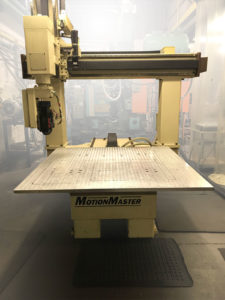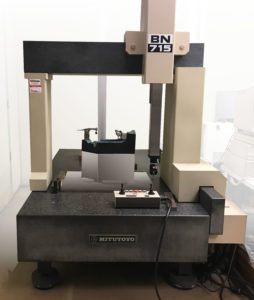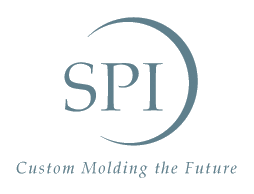Molding
Our leadership staff has 150+ years in molding experience. SPI can meet any of your custom blow molding needs with a variety of plastics including HDPE, ABS, polycarbonate, and TPE. SPI’s Molding technology consists of family molds, insert molding, multi-cavity and trapped air molding. Our facility is equipped with three dual head presses and ten single head presses ranging in tonnage from five tons to 200 tons of clamp force and has shot capacities ranging from 1.0 # to 42 #.
Equipment List
| PRESS # | PRESS NAME | SHOT | HEAD | CLAMP | TON | SCREW | HDPE OUTPUT |
CLAMP WXH |
MIN. DAYLT. |
MAX. DAYLT. |
HEAD. MIN. |
TOOLING. MAX. |
HEAD CENTER |
| 1 | B30 | 2.5 # | 2 | 1 | 40 | 3.5″ | 410 | 30X30 | 16″ | 36″ | .500″ | 6″ | 15″ |
| 2 | B30 | 2.5 # | 2 | 1 | 40 | 3.5″ | 410 | 30X30 | 16″ | 36″ | .500″ | 6″ | 15″ |
| 3 | STERLING | 8.5 # | 1 | 1 | 70 | 3.5″ | 550 | 50X40 | 12″ | 50″ | 4″ | 12″ | |
| 4 | RTD | 1.0 # | 1 | 1 | 5 | 2.0″ | 120 | 15X12 | 9″ | 24″ | .200″ | 4″ | |
| 5 | RTD | 1.0 # | 1 | 1 | 5 | 2.0″ | 120 | 15X12 | 9″ | 24″ | .200″ | 4″ | |
| 6 | STERLING | 42 # | 1 | 1 | 150 | 4.6″ | 750 | 50X66 | 26″ | 70″ | 8″ | 24″ | |
| 11 | STERLING | 20 # | 1 | 1 | 150 | 4.5″ | 750 | 44X60 | 12″ | 60″ | 3.9″ | 16″ | |
| 12 | BEKUM | 13 # | 1 | 1 | 75 | 3.5″ | 300 | 50X40 | 10″ | 48″ | 3.9″ | 16″ | |
| 13 | HARTIG | 35 # | 1 | 1 | 175 | 3.5″ | 550 | 42X56 | 24″ | 50″ | 3.9″ | 16″ | |
| 15 | STERLING | 3 # | 2 | 1 | 20 | 3.5″ | 500 | 20X34 | 10″ | 40″ | 1″ | 6″ | 17″ |
| 16 | HARTIG | 15 # | 1 | 1 | 65 | 3.5″ | 550 | 32X40 | 14″ | 50″ | 3.9″ | 16″ | |
| 17 | STERLING | 40 # | 1 | 1 | 200 | 4.5″ | 750 | 48X56 | 10″ | 60″ | 9.0″ | 24″ | |
| 20 | HARTIG | 15 # | 1 | 1 | 70 | 3.5″ | 550 | 38X30 | 12″ | 50″ | 3.9″ | 16″ | |
| 21 | Pet All | 20 # | 1 | 1 | 17 | 3.9″ | 529 | 37X43 | 23″ | 55″ | 4″ | 14″ |
Materials
Materials – SPI- Blow Molding Materials: We understand choosing a material for your project can be overwhelming as the possibilities are endless. SPI works hard to ensure we are up to date on the latest material science and offers effective solutions for our customers material selection for their product sustainability and success.
Here is a list of common materials used in blow molding and by SPI to assist you with product evolution.
SPI- Blow Molding Materials:
- ABS – Blow molding grade ABS is typically opaque and colored for use in electronics housings and small appliances. ABS molds well after drying. However, parts made from ABS aren’t as chemically resistant as PE or PP, so caution must be used with parts that come in contact with chemicals. ABS is recyclable as code 7, but its toughness makes grinding difficult. Density- 1.20 g/cc, High Heat Deflection- 190°F, Hardness- Shore 85D
- EVA – It’s an extremely elastic material that can be sintered to form a porous material similar to rubber, yet with excellent toughness. The porous elastomeric material is three times as flexible as low-density polyethylene (LDPE), showing tensile elongation of 750% with a peak melting temperature of 250°F (96°C). Hardness- 15-80 degree ShoreC, Density- 33kg/m – 280 kg/m, High Heat Deflection- 73°F
- Polystyrene – a tough, rigid plastic material with high impact strength which can be guillotined, punched, routered or sawn easily, and is readily available in a wide variety of colors. Used widely for toys, packaging, signs, kicking plates, display and point of sale. If you are looking for a particular colored plastic with good impact properties then HIPS is a first-choice material. Polystyrene is particularly suitable for thermoforming meaning various shapes and objects can be produced from this material. Polystyrene is recycled under code 107. Density- 1.08 (g/cm), High Heat Deflection- 284°F, Hardness- Shore 62-75D
- TPO – Thermal Plastic Olefin is a thermoplastic polyolefin elastomer plastic material with a medium high melt flow, 650 MPa flexural modulus and low CLTE. Paintable thermoplastic elastomeric olefin (TEO) resin has an exceptional combination of stiffness, impact resistance and dimensional stability. Density- 0.880 (g/cc), Hardness- Shore 65D
- TPR – These compounds are formulated using Styrene-Butadiene-Styrene (SBS) or Styrene-Ethylene/Butylene-Styrene (SEBS) block co-polymers. These materials have many of the same properties as vulcanized rubbers, but can be molded and extruded using conventional thermoplastic process equipment. Thermoplastic processing provides advantages over vulcanized, thermoset rubbers which are processed using a slower and more costly curing process. Most of our TRP formulations are 100% recyclable and are RoHS compliant. Density- 0.85-1.2 (g/cc),
- PC/ABS – (polycarbonate-ABS) is one of the most widely used industrial thermoplastics. PC-ABS offers the most desirable properties of both materials – the superior strength and heat resistance of PC and the flexibility of ABS. PC-ABS blends are commonly used in automotive, electronics and telecommunications applications. ABS is recyclable under code 9. Density- 1.20 (g/cc), Hardness- Shore 82D, High Heat Deflection- 290°F
- Nylon (Polyamide) – Nylon resins are typically used in applications requiring heat and chemical resistance, as well as, toughness. Some examples include under-the-hood automotive components, electrical connectors for the telecommunications and computer industries and components of medical devices. Nylon products can be found in virtually every industry. Parts in a broad range of colors can be produced with most nylon resins. Polyamide is recyclable under code PA. Density- 1.15 (g/cm3), Hardness- Shore 80D, High Heat Deflection- 200°F
- Polyethylene (HDPE) – HDPE is the world’s #1 plastic and the most commonly blow molded plastic material. It’s used in a vast array of products, including bottles for consumer liquids such as shampoo and motor oil, coolers, play structures, fuel tanks, industrial drums, and carrying cases. It’s molder-friendly, translucent and easily colored, and chemically inert (FDA approved and perhaps the safest of all plastics). PE the most commonly recycled resin with recycling code designation 2. Density- 0.95 (g/cc), High Heat Deflection- 160°F, Shore 65D
(LDPE)- Variations of LDPE include linear-low (LLDPE) and combinations with ethyl-vinyl-acetate (LDPE-EVA). LDPE is used for softer products that require a high level of stress crack resistance or flexibility. Generally, the higher the ethyl-vinyl-acetate (EVA) content, the softer the molded part. Common applications include squeeze bottles, traffic channelizers, and boat fenders. The highest usage is blown film for plastic bags. It is also molder-friendly, translucent and easily colored, chemically inert, and commonly recycled under code 4. Density- 0.92 (g/cc), High Heat Deflection- 140°F, Hardness- Shore 55D - Flexible PVC – Although PVC is the world’s #3 plastic, it has been heavily scrutinized for using cadmium and lead as stabilizers, releasing hydrochloric (HCl) acids during processing, and releasing residual vinyl chloride monomers after molding (most of these problems have been reduced). PVC is translucent and comes in rigid and soft forms — the soft resin is typically used in blow molding. Common applications include soft medical parts, bellows, and traffic cones. Special processing equipment is recommended to prevent corrosion from HCl. PVC is recyclable under code 3. Density- 1.38 (g/cm3), Hardness- Shore 75-95A
- PPO – PPO is an opaque resin. It requires drying and has a limited drawdown capacity during molding. This restricts designers to PPO parts with generous blow ratios or flat shapes, such as panels and desktops. Molded parts are stiff and relatively strong. Like ABS, PPO grades can pass UL 94 V-0 flammability criteria. It can be reprocessed, and a few recyclers accept it under code 7. Density- 1.10 (g/cc), High Heat Defection- 190°F, Hardness- Shore 85D
- Acrylic – Hardness- Shore 87.2D, Density 1.185 (g/cm3), High Heat Deflection- 150-210°F
- Polycarbonate – Polycarbonates are a group of thermoplastic polymers containing carbonate groups in their chemical structures. Polycarbonates used in engineering are strong, tough materials, and some grades are optically transparent. They are easily worked, molded, and thermoformed. Because of these properties, polycarbonates find many applications. Polycarbonate is recyclable under code 7. Density- 1.20 (g/cm3), High Heat Deflection- 290°F, Hardness-Shore 80D
- Polysulfone – Polysulfones are a class of engineering polymers with high thermal, oxidative and hydrolytic stability. They are amorphous, transparent thermoplastics that can be molded, extruded, or thermoformed into a wide variety of shapes. The usual grades have a good melt stability which permits fabrication by conventional thermoplastic processing methods. Polysulfone recycling is common under code 109. Density- 1.24 (g/mL), High Heat Deflection- 345°F, Hardness- Shore 80D
- Polypropylene (Filled or Unfilled) – PP is the world’s #2 plastic — it’s an extremely popular injection molding resin. PP is similar to HDPE, but slightly stiffer and lower density, which provides some advantages. PP is commonly used in elevated temperature applications, such as dishwasher tubes and medical parts that require autoclave sterilization. It’s molder-friendly as well as translucent and easily colored. Some clarified versions provide “contact clarity.” PP recycling is common under code 5. Density- 0.90 (g/cc), High Heat Deflection- 170°F, Hardness- Shore 75D
- PET/PETG Copolyester – PET is a polyester that is usually injection blow molded into clear containers. While it isn’t impossible to extrusion blow mold PET, it is less common, as the resin requires extensive drying. The largest PET blow molding market is for soft drink and water bottles. PET recycling rates are growing under recycle code 1. Desinty- 1.20 (g/cc), High Heat Deflection- 160°F, Hardness- Shore 80D
- Santoprene – Santoprene is fully dynamically vulcanized ethylene propylene diene monomer (EPDM) rubber in a thermoplastic matrix of polypropylene (PP). It looks, feels and behaves like rubber but, due to the PP content, offers simple, flexible part design and manufacturing. It has proven to be a dependable polymer for flexible engineered parts that require long-term performance. With the potential for reduced system costs, compared to materials such as thermoset rubber, and the potential for sustainability benefits, Santoprene TPV has become the global standard for engineered TPV. Density- 0.95 (g/cm3), Hardness- Shore 94A
- Thermoplastic Elastomer – Thermoplastic elastomers (TPE), sometimes referred to as thermoplastic rubbers, are a class of copolymers or a physical mix of polymers (usually a plastic and a rubber) which consist of materials with both thermoplastic and elastomeric properties. Thermoplastic elastomers show advantages typical of both rubbery materials and plastic materials. The benefit of using thermoplastic elastomers is the ability to stretch to moderate elongations and return to its near original shape creating a longer life and better physical range than other materials. Density- 1.14 (g/cm3)
- Kostrate – This new thermoplastic material, which serves as a cost-effective alternative to polycarbonate, exhibits exceptional toughness, rigidity and clarity. Kostrate is a significant cost-saving alternative for clear applications where rubber modified polystyrene, polycarbonate and copolymer polyester may have been used. Compared to other clear and engineered materials, Kostrate offers the following: high impact, high flexural and tensile strength. Density- 1.20(g/cm3), High Heat Deflection- 200°F
***We have the capability to blend and process a wide range of fillers including talc, calcium carbonate, glass, UV, and custom color concentrates. ***
Secondary Operations
We put the ‘custom’ into Custom Blow Molding. We design specialty trim and drill fixtures to ensure your parts can be made to exacting specifications.
CNC
 CNC – SPI manages many different trim and drill methods. One of the most common methods is through the use of the Motion Master 5 Axis CNC 8055M with a trimming window 48x54x32. CNC routers are automated cutting solutions aimed at accelerating the output of manufacturing processes while enhancing the product quality. 5-axis machining provides infinite possibilities as to the part sizes and shapes you can effectively produce. The term “5-axis” refers to the number of directions in which the cutting tool can move. On a 5-axis machining center, the cutting tool moves across the X, Y and Z linear axes as well as rotates on the A and B axes to approach the workpiece from any direction. In other words, you can process five sides of a part in a single setup. When used in tandem with advanced design software, CNC machines can create outputs that cannot be replicated by manual machines.
CNC – SPI manages many different trim and drill methods. One of the most common methods is through the use of the Motion Master 5 Axis CNC 8055M with a trimming window 48x54x32. CNC routers are automated cutting solutions aimed at accelerating the output of manufacturing processes while enhancing the product quality. 5-axis machining provides infinite possibilities as to the part sizes and shapes you can effectively produce. The term “5-axis” refers to the number of directions in which the cutting tool can move. On a 5-axis machining center, the cutting tool moves across the X, Y and Z linear axes as well as rotates on the A and B axes to approach the workpiece from any direction. In other words, you can process five sides of a part in a single setup. When used in tandem with advanced design software, CNC machines can create outputs that cannot be replicated by manual machines.Quality
Our quality standards meet the ISO-9001-2015 requirements to ensure our customers get the best quality parts they deserve. We firmly believe that everyone is responsible for quality, from the engineer who designs the tools, to the operator who molds the part, to the quality auditor who inspects the finished part. We are committed to continuous improvement practices to ensure we exceed our customer expectations in every aspect of the manufacturing process.
CMM
 CMM – SPI uses a Coordinate measuring machine CMM Mitutoyo BN715, to identify different types of measurements including dimensional, profile, angularity, depth mapping, and shaft measurements to ensure precision and accuracy in every part we produce. CMMs are comprised of three main components: the machine itself, the measuring probe, and the control or computing system with appropriate measuring software. After placing a workpiece on the machine table, a probe is used to measure different points on it by mapping the x, y, z coordinates. The probe operates manually via an operator. These points are then uploaded to a computer interface where they are analyzed using modeling software and regression algorithms for further development.
CMM – SPI uses a Coordinate measuring machine CMM Mitutoyo BN715, to identify different types of measurements including dimensional, profile, angularity, depth mapping, and shaft measurements to ensure precision and accuracy in every part we produce. CMMs are comprised of three main components: the machine itself, the measuring probe, and the control or computing system with appropriate measuring software. After placing a workpiece on the machine table, a probe is used to measure different points on it by mapping the x, y, z coordinates. The probe operates manually via an operator. These points are then uploaded to a computer interface where they are analyzed using modeling software and regression algorithms for further development.Assembly
As a full-service blow molder, we provide a broad range of product assembly services to our clients. We can source components, add decals and instructions sheets, plus assemble products per our customer’s requirements.
Assembly services can also include full product pack-out capabilities. Our full product pack-out service involves packaging assembled components, including custom hardware, into retail packaging which can be directly drop shipped. Let us know your special-order fulfillment requirements and we’ll work with your budget and timeline.
